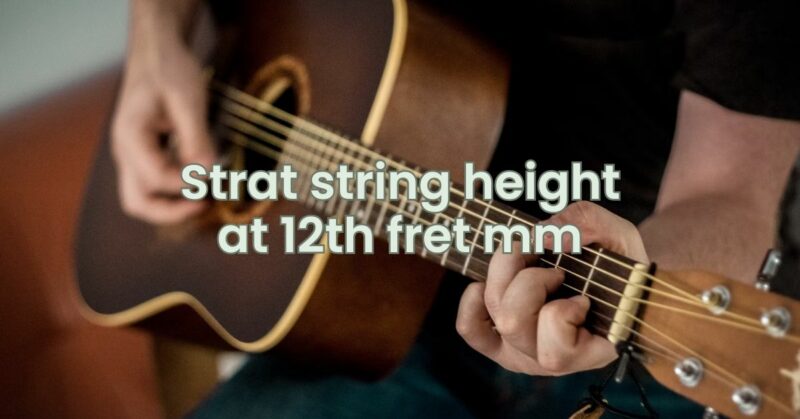For guitarists, achieving the ideal playability and tone from their instrument is a pursuit that knows no bounds. One essential aspect of this endeavor is setting the string height, also known as action, at the 12th fret of a Fender Stratocaster or “Strat” style guitar. This seemingly small adjustment can make a significant impact on your playing experience. In this article, we’ll dive into the world of string height, exploring its importance, the factors to consider, and how to strike the right balance between playability and tone.
Why String Height Matters
String height refers to the distance between the bottom of the strings and the top of the frets, specifically at the 12th fret. This seemingly minute detail can have a profound effect on how your guitar feels and sounds. An optimal string height enhances playability, allowing for comfortable fretting and bending, while also influencing the guitar’s overall tonal characteristics.
Factors Influencing String Height
Several factors come into play when determining the ideal string height for your Strat:
- Playing Style: Your playing style heavily influences the preferred string height. Players who use aggressive techniques like heavy strumming or vigorous bending might prefer slightly higher action to prevent excessive buzzing, while lighter players might opt for lower action for faster fretting.
- String Gauge: The gauge of your strings (thickness) affects the tension they exert on the neck. Lighter gauge strings create less tension, allowing for lower action, whereas heavier strings may require slightly higher action to prevent fret buzz.
- Neck Radius: The curvature of your guitar’s fretboard, known as the neck radius, plays a role in determining string height. A flatter radius allows for lower action across all strings, while a more curved radius might require slightly higher action towards the outer strings.
- Playing Environment: The environment in which you play also matters. Changes in temperature and humidity can cause the neck to bow or warp, affecting string height. Regular adjustments might be needed to accommodate these variations.
Achieving the Perfect Balance
While there’s no universal “correct” string height, achieving the perfect balance for your playing style and preferences is key. Here’s a step-by-step guide to help you set the string height at the 12th fret of your Strat:
- Measurements: Use a ruler or specialized string action gauge to measure the distance between the bottom of the strings and the top of the 12th fret. The typical range for Strat-style guitars is around 1.6mm to 2.4mm for the low E string and 1.2mm to 1.8mm for the high E string.
- Adjust Bridge Height: Stratocaster guitars usually have individual saddle height adjustments for each string. Use a screwdriver to raise or lower the saddle of each string as needed to achieve the desired height.
- Check Clearance: Play each string at various points along the neck to ensure there’s no excessive buzzing. Adjust individual string heights if needed to eliminate buzzing while maintaining comfortable playability.
- Fine-Tuning: Once you’ve made the initial adjustments, play your guitar and gauge the playability. If it feels comfortable and there’s no noticeable buzzing, you’re on the right track.
- Listen to the Tone: While comfort is crucial, don’t forget about the impact on your guitar’s tone. Higher action can contribute to more sustain and a slightly brighter tone, while lower action might yield a faster attack and smoother feel.
Conclusion
Setting the string height at the 12th fret of your Strat guitar is a delicate balance between comfort and tone. By considering your playing style, string gauge, neck radius, and the overall playing environment, you can dial in the perfect action that suits your preferences. Remember, the journey to finding your ideal string height is as much about experimentation as it is about precise measurements. So, grab your tools, make some adjustments, and let your Strat sing with the perfect balance of playability and tone.

